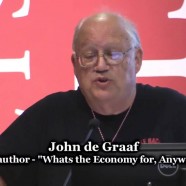
In a world where 16,000 children die of hunger-related diseases every day—five September 11 holocausts every day, almost unnoticed—we Americans have ample reason to be grateful for the bounty of food we take for granted. Indeed, while hunger in America is increasing due to the elimination of food stamp benefits and greater inequality, we are more likely to die in America from the complications of eating too much. But we show precious little gratitude for our cornucopia and even less for the people who produce it. From Jefferson to Tocqueville to Bryan and well beyond, farming was once an honored profession in America. It is no more, but it can be again.
When poet Vachel Lindsay (1879-1931) walked from Springfield, Illinois to Santa Fe, New Mexico, in 1912 preaching his “gospel of beauty,” he commented on the vibrancy of rural communities and farms, especially in Kansas with its great golden wheat fields, and celebrated the democratic agrarian life in our rural communities. Today, the small towns Lindsay passed through have been in steep decline for years, hollowed out as industrial agriculture cast the small farmer aside and catalyzed a massive migration to our cities instead of our wheat fields. This hollowing out has left rural communities poverty-stricken, forlorn and drug-addicted. In his The New Localism, Lindsay argued that every school should train its students to leave their small towns briefly and learn from the world outside, but then return to serve them. Sixty years later, another poet, Gary Snyder, suggested that parents should teach their children to find a good place, stay there, learn the biology, grow things, and create community and permanence.
It’s starting to happen. In recent years, beginning with the back-to-the-land movement of the late 1960s, many young Americans have sought a reconnection with nature and with food, establishing as best they can, small organic and sustainable farms. In the state of Oregon, the number of new farmers far exceeds those who are leaving the land. Local farmers’ markets have sprouted from small towns to New York City. These markets don’t only provide fresh, local, organic food. They build community—Bill McKibben reports ten times as many conversations per capita in farmers’ markets than in supermarkets.
Urban farms have emerged in some of our most distressed cities. In Milwaukee, former NBA basketball player Will Allen established Growing Power, an organization that raises millions of dollars’ worth of food in former vacant lots, providing produce for fine restaurants and jobs for hundreds of urban teens, moving many out of gangs. Michael Howard has done the same with Eden Place in Chicago, and added a nature center where inner-city kids can connect to living, growing things.
Organic farmers, like my friend John Tecklin in Nevada City, California, provide internships for city kids wanting to farm. He gets a hundred volunteers each year, many times more than he can accommodate. Craig McNamara, the son of former Defense Secretary Robert McNamara and an organic walnut farmer in Winters, California, runs the Center for Land-Based Learning, which introduces dozens of inner-city kids to summer work on farms. Many want to become farmers.
Some Americans have had great success promoting natural foods. Michael Funk was a garbage man in Sacramento, California, in the early 1970s, “the only job you could get as a long-haired hippie,” he now says. He started picking organic fruits and selling them to health food stores and started a small organic food distribution company called the Mountain People’s Warehouse. Today, his once-tiny company is the publicly-traded UNFI, the largest distributor of organic food in America, providing much of the produce for Whole Foods. But he never expected such an outcome. “I just thought selling fruit was better than being a garbageman,” he told me recently.
These are great beginnings that should be brought to scale throughout our nation. That’s where the gratitude comes in. It costs more to grow food in sustainable ways, with more hand labor and without chemicals and pesticides. And with little gratitude for food, we Americans want it cheap. Our average bite of food travels 1500 miles. Somehow, given the strange and narrow logic of American capitalism and the fact that we don’t pay in the market for the long-term environmental costs of our purchases, it’s cheaper to buy machine-grown, chemicalized, long-distance food than locally-grown organic produce. But, in reality, we all pay for the destruction wrought by industrial agriculture, whether it be in the pollution of water sources or the loss of topsoil.
As a start, gratitude for food would fund a national college program to train young people to become effective sustainable farmers—our STEM programs would turn to STEAM, realizing that if anything, agriculture is even more important than science, technology, engineering and math.
Let’s give thanks for our bounty by assuring that our land and our farmers can keep going.
John De Graaf is a writer, filmmaker, and author. Since 1977, he has produced more than 40 documentaries, and dozens of shorter news stories and films. He has written dozens of articles for such publications as The Progressive, The Nation, The New York Times and many others. He is the author or co-author of four books, including Affluenza, which is an international best-seller.










